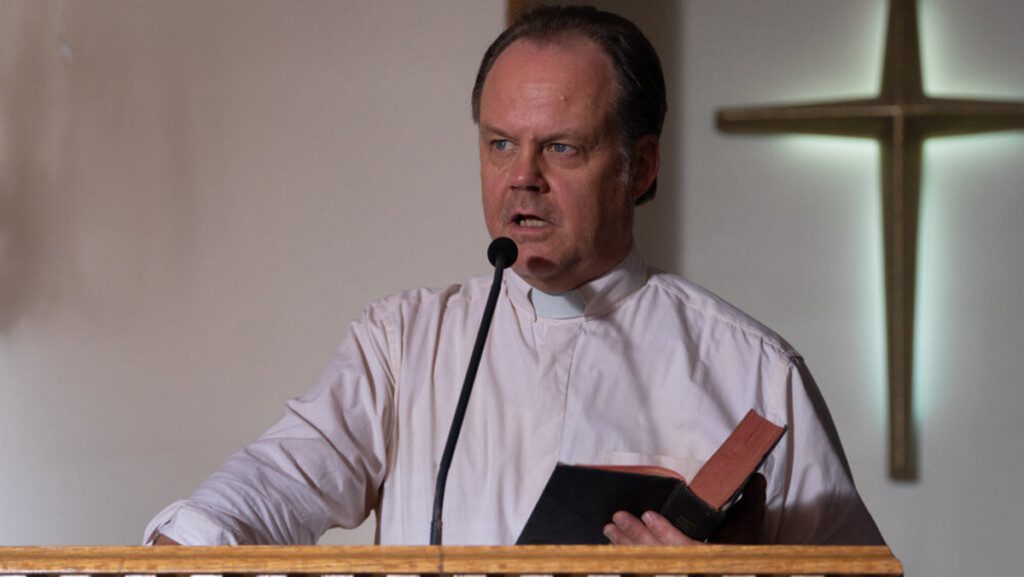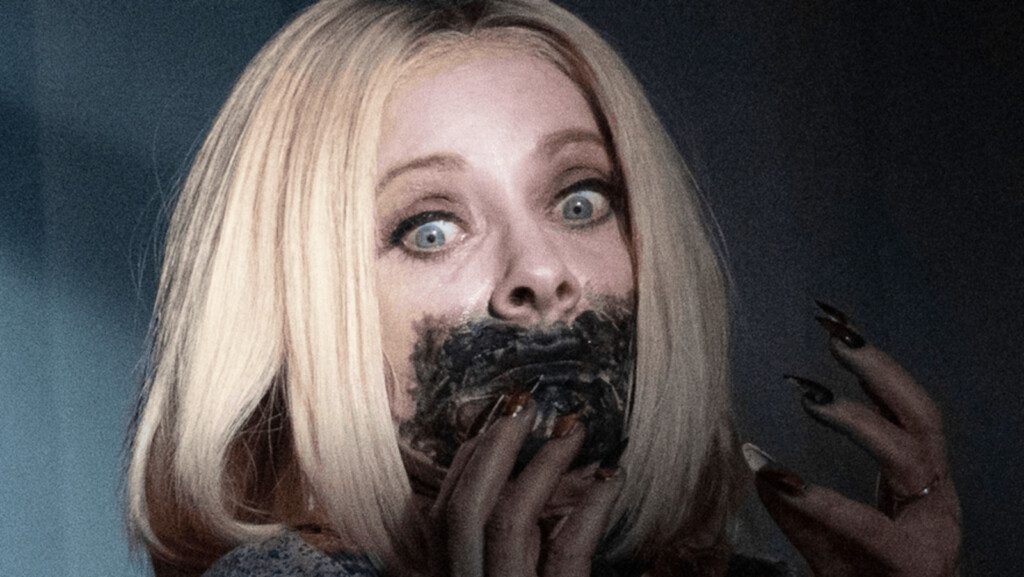“My thoughts are drenched in blood.”
Horror has a Barbara Crampton problem. The problem isn’t with Crampton herself, who has been an icon of the genre since Re-Animator came out 39 years ago. The problem is that modern directors don’t know how to use her; much the same way that Rob Zombie will cast his “films” with horror mainstays like Dee Wallace and Ken Foree, directors these days seem to be under the misapprehension that casting Crampton will give them some street cred, so to speak. It happened with last year’s incomprehensibly bad Suitable Flesh, and before that it happened with 2021’s Jakob’s Wife, which, while not as execrable as Suitable Flesh (few things are), is still mostly a waste of her talent and screen presence. It’s nice to see her in a lead role, but if this is the material she’s being offered, she should consider sticking to the solid supporting work she did in You’re Next and We Are Still Here.
Crampton plays Anne Fedder, the meek, put-upon wife of the town’s pastor, Jakob (Larry Fessenden). She stands quietly by her garrulous husband’s side, and whenever she happens to speak, Jakob talks over here and interrupts her with surgical precision. Jakob is a clueless good ol’ boy, straightforward and simple-minded; his white vestments speak to an incurious, almost virginal attitude. Jakob snores and even manages to brush his teeth with too much annoying enthusiasm, so it’s not surprising that Anne makes plans to meet up with an old boyfriend of hers, Tom, who she wants to hire to restore a historic gin mill. (Jakob calls Tom Anne’s “old flame,” a good example of this film’s stilted dialogue.)

Fessenden does a reasonable job as a doofus who believes that his authority in the church translates to authority elsewhere, but the movie really frontloads just how miserable Anne’s home life is. So when she and Tom enter the gin mill – where they used to fool around as kids – it’s not shocking that they end up kissing. As Anne begins to pull away, they hear a thumping from one of a few suspicious wooden crates. Tom investigates, and the affair is cut off at the legs – or swarmed at the face – as Tom is devoured by rats. (Rats are everywhere in Jakob’s Wife, and it’s one of the film’s better Gothic touches.) Anne is then attacked by a being we’ll come to know as the Master.
What we have here is a more-or-less straightforward vampire story, with an undercurrent of female rage. It’s not without its good moments. The day after Anne gets bit, she’s working out – in lipstick and earrings, as if to boldly reclaim her femininity – and Jakob seems genuinely confused by the absence of breakfast. “I’m not hungry,” Anne replies, without ever making eye contact. Jakob’s Wife does well in small moments like that, but overall it’s too disjointed to fully recommend. (The director, Travis Stevens, helmed previous 31DOF entry Girl on the Third Floor, which at the time I was lukewarm towards. In retrospect it’s a much better piece of horror because it doesn’t over-burden itself.)
The film is not without its charms, though. Crampton does solid work as Anne; the movie lives or dies by her performance, as she’s in nearly every scene, and she carries that weight nicely. Beyond being beautiful, there’s an intriguing distance to Crampton as an actor that makes one want to watch until she opens up (this worked to great effect in From Beyond). The design of the Master is pretty great: half Count Orlok from Nosferatu, half Barlow from ‘Salem’s Lot. The Master has a masculine physique but feminine features and voice, a decidedly sexless creature. Bonnie Aarons, best known as the evil nun Valek from the Conjuring universe, dives head-first into a wordier performance than we’re used to seeing from her, and she aces it. That aside, though, the score might be the highlight of Jakob’s Wife. Composed by Tara Busch, scoring her first feature-length film, the music is eerie and atmospheric when it needs to be, punctuated by occasional harpsichord or theremin flourishes. It doesn’t so much flirt with camp as it acknowledges it without ever going over the edge. If you skip this movie – and you can – check out the music at the very least. The makeup, too, is nicely done. There’s no attempt to make vampires sexy; when Anne’s new teeth sprout out of her head, they look uncomfortable and unwieldy.

Where Jakob’s Wife stumbles in a way impossible to correct is in its second act, when Jakob discovers Anne’s new appetites. In short order he goes from an uptight religious prig to someone happy to lie to the police and help Anne bury the body of a nosy neighbor. Stevens tries, unsuccessfully, to add dark comedy to everything that’s already on his film’s plate. He’s going for something like Santa Clarita Diet or a farcical version of Hellraiser, which doesn’t work because he’s also still trying to make the film scary. It’s not completely bereft of scares, but generally speaking, everyone – especially Jakob – takes things in stride just a little too much.
That’s to say nothing of the pacing, with which Stevens struggles mightily. There’s no compelling reason for this film to be nearly two hours long. You can see him padding the length almost in real time, as evinced by a scene where Anne dances around the house (to what sounds like a house remix of Shivaree’s “Goodnight Moon”) and rearranges the furniture with her incredible new strength. The dancing doesn’t lead anywhere, and her strength is never remarked upon. Ditto the new living room arrangement.
Jakob’s Wife has a lot on its mind, which is commendable if not unique, as horror is getting more cerebral every year. I think Stevens is just still struggling with the language of film, which makes me wonder if I should even bother with his latest, 2022’s A Wounded Fawn. The vampire stuff works just fine, as did the monster stuff in Girl on the Third Floor, so it’s possible that with Jakob’s Wife he’s punching above his weight class. But this isn’t about Travis Stevens; it’s about Barbara Crampton, who we all love. So why can’t we stop letting her down?

